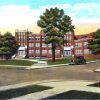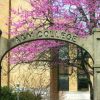calsfoundation@cals.org
Arkadelphia Male and Female Institute
aka: Arkadelphia Institute
aka: Arkadelphia Female Seminary
aka: Arkadelphia Female College
aka: Arkadelphia Female Academy
Several educational institutions with variations of the name Arkadelphia Male and Female Institute operated in Arkadelphia (Clark County) during the nineteenth century. The first opened in 1850.
Arkadelphia was the seat of Clark County, with a population of 248 in 1850. With a newspaper, several churches, and a saloon, the town was one of the larger settlements along the Ouachita River. Early efforts to open a school in the town began in 1843. That year, an election was held in Arkadelphia to select three trustees to create a school and sell part of the sixteenth section on the west side of the Ouachita. Three trustees were elected, but one died before taking office, and little progress was made toward opening a school.
A Baptist minister, Samuel Stevenson, arrived in Arkadelphia as a representative of the American Bible Society. Stevenson was a native of Philadelphia, Pennsylvania, and a graduate of Georgetown College in Kentucky. Arriving in Clark County around 1848, he first operated a school at Oakland (Clark County) eight miles from Arkadelphia. He constructed a two-story frame building with a cupola and opened the Arkadelphia Institute in 1850 with help from his nephew James Gilkey. Gilkey served as the principal for male students, and Elizabeth Ann Webb took a similar role over the female students. By 1852, the school had an enrollment of ninety-seven. The school was known by a variety of names during its operations, including Arkadelphia Institute, Arkadelphia Male and Female Institute, and Arkadelphia Female Seminary.
With the start of the Civil War, the school continued to operate for a time but soon closed. Federal troops ransacked the building during their brief occupation of Arkadelphia during the Camden Expedition. At the conclusion of the war, Stevenson reopened the school but sold it in 1869 to Mary Connelly, who previously served as a teacher at the institution. Connelly worked as a teacher in Camden (Ouachita County) and in other states before the war and moved to Arkadelphia in 1866. She renamed the school the Arkadelphia Female College, and the school offered a variety of secondary and college-level courses. Classical language courses and art courses were popular offerings. The students also held concerts at the local Baptist church to raise money to establish a library at the school. Enrollment numbers for the institution do not survive, but numerous girls from the local community attended the school.
The organization of Arkadelphia High School by local Republicans as a free institution open to members of the community signaled the end of the private, tuition-driven school. Connelly closed Arkadelphia Female Academy in June 1874. The building was later used to house Arkadelphia Female High School, which was organized along with Arkadelphia Male High School in 1875.
The Arkadelphia Institute paved the way for future educational institutions to open in the city, including Ouachita Baptist University, Henderson State University, and Shorter College.
For additional information:
Caffee, Barbara. “Antebellum Arkadelphia, 1800–1850.” Clark County Historical Journal (Spring 1981): 63–71.
Granade, Ray, and Wayne McAfee. “The Development of Education and Culture in the Arkadelphia Region.” Clark County Historical Journal (Spring 1984): 1–49.
Newberry, Farrar. “The Yankee Schoolmarm Who ‘Captured’ Post-War Arkadelphia.” Arkansas Historical Quarterly 17 (Autumn 1958): 265–271.
Richter, Wendy, et al. Clark County Arkansas: Past and Present. Arkadelphia, AR: Clark County Historical Association, 1992.
Sperry, A. F. History of the 33rd Iowa Volunteer Infantry Regiment, 1863–6. Edited By Gregory Urwin and Cathy Urwin. Fayetteville: University of Arkansas Press, 1999.
David Sesser
Henderson State University
 Civil War through Reconstruction, 1861 through 1874
Civil War through Reconstruction, 1861 through 1874 Education, Elementary and Secondary
Education, Elementary and Secondary Education, Higher
Education, Higher Arkadelphia Female College Ad
Arkadelphia Female College Ad 




Comments
No comments on this entry yet.